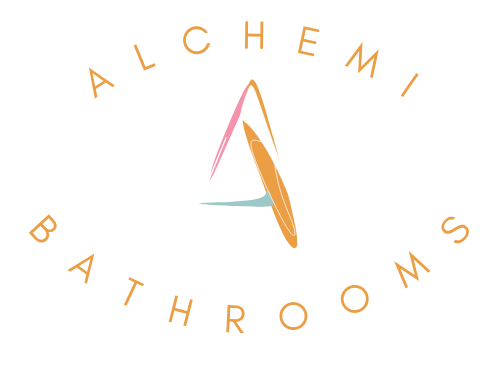Rethinking the Tile
Oh, the dreaded tile! When it comes to tackling a bathroom renovation, ripping out the old tile seems to be the bane of every DIYer’s existence. I can still vividly recall the dust-filled nightmare that was our kitchen tile removal a couple years back. Shad and I spent two grueling days chiseling away at that stubborn tile, only to be left with a floor coated in a thick layer of hard cement adhesive. With the flooring installers due to arrive in just 24 hours, we had to rent a heavy-duty cement grinder to get the job done. By the time we were finished, our house looked like the aftermath of a warzone and I swore I’d never put myself through that kind of torture again.
So when it came time to address the outdated tile in our upstairs guest bathroom, I was determined to find a solution that didn’t involve demolition. I just couldn’t fathom subjecting our home (and my poor lungs) to that level of chaos. After some research, I landed on a brilliant idea that not only saved us from the tile removal headache, but also gave the space a fresh new look – tile stickers! [1]
Tile Stickers to the Rescue
Tile stickers, also known as peel-and-stick tiles, have come a long way in recent years. Gone are the cheap, plasticky varieties of the past. Nowadays, you can find high-quality vinyl tiles that mimic the look of real stone, marble, and even wood for a fraction of the cost of a full tile replacement. And the best part? You can simply apply them right over your existing tiles without any messy demolition.
I spent hours scouring the internet for the perfect pattern and color palette to complement the rest of our guest bathroom design. After much deliberation, Avery and I settled on a beautiful star-patterned tile in a soft blue hue. The installation process ended up being a breeze – I was able to transform the entire floor in just about an hour! [2]
The Key to Success
Of course, there are a few tricks to ensuring your tile sticker project is a success. The most important thing is to make sure you order the stickers slightly smaller than your existing tiles, leaving a small border around the edges. This allows the sticker to adhere to a flat surface all the way around, preventing those pesky corner peels.
Another crucial step is to thoroughly clean and prepare the floor before application. I started by using a TSP cleaner to degrease and de-grime the tiles, then went in with a paint brush to touch up the grout lines. This helped the stickers grip the surface seamlessly. [3]
The Moment of Truth
I’ll admit, I was a bit skeptical at first about how well these tile stickers would hold up, especially in a high-traffic bathroom. But I’m happy to report that over 16 months later, they’re still going strong! The floors have stood up beautifully to daily use, wet feet, and even our massive Bernese Mountain Dog. No peeling, ripping, or signs of wear and tear whatsoever. [4]
In fact, the transformation has been so impressive that we ended up using the same approach in our younger daughter Attley’s bathroom a few months later. The process was just as easy and the results were equally stunning. I love that we were able to completely refresh the space for a fraction of the cost of a full tile replacement.
Beyond the Floor
Of course, updating your bathroom tile doesn’t have to stop at the floor. The same peel-and-stick concept can be applied to walls, backsplashes, and even shower surrounds for a quick and easy facelift. [5] Just be sure to steer clear of using them directly in the shower, as the constant water exposure could potentially lead to mold and mildew issues down the line.
Personally, I opted to stick (pun intended) to the floor in both of our daughters’ bathrooms. But I’ve seen some truly stunning DIY transformations using tile stickers on accent walls and vanity backsplashes. The options are endless when it comes to getting creative with these versatile little squares.
A Final Word of Caution
While tile stickers can be a game-changing solution for outdated bathrooms, there are a few caveats to keep in mind. First and foremost, make sure you measure your existing tiles meticulously and order the stickers slightly smaller, as I mentioned earlier. Trying to fit them edge-to-edge or, heaven forbid, overlapping the grout lines is a surefire way to end up with peeling corners and an unsightly mess.
Secondly, be prepared for a bit of a time investment, especially if you have a larger area to cover. It took me around 8 hours to complete each of our daughters’ bathrooms, working in small sections and carefully blending the edges. But trust me, the end result is more than worth the effort.
At the end of the day, tile stickers provide an incredibly affordable and mess-free way to breathe new life into an aging bathroom. No jackhammers, no dust, no construction chaos – just a fresh, stylish floor that’s ready to impress. So if you’re feeling stuck with outdated tiles, don’t despair. With a little creativity and elbow grease, you can transform your space into a stunning, Instagram-worthy oasis. Happy sticking!
References
[1] Knowledge from https://www.younghouselove.com/how-you-like-me-now-grout/
[2] Knowledge from https://www.youtube.com/watch?v=qOeDjOeH2Qk
[3] Knowledge from https://designertrapped.com/home/2018/4/15/ideas-for-covering-up-tile-floors-without-removing-it
[4] Knowledge from https://www.thedecorformula.com/home/2018/4/15/ideas-for-covering-up-tile-floors-without-removing-it
[5] Knowledge from https://www.youtube.com/watch?v=hzogRM-E_sU
